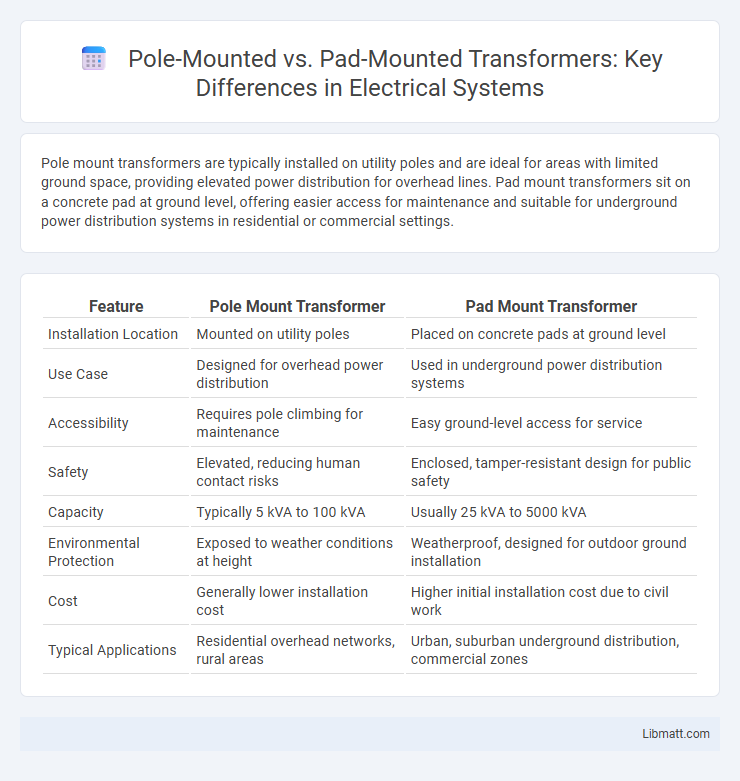Pole mount transformers are typically installed on utility poles and are ideal for areas with limited ground space, providing elevated power distribution for overhead lines. Pad mount transformers sit on a concrete pad at ground level, offering easier access for maintenance and suitable for underground power distribution systems in residential or commercial settings.
Table of Comparison
| Feature | Pole Mount Transformer | Pad Mount Transformer |
|---|---|---|
| Installation Location | Mounted on utility poles | Placed on concrete pads at ground level |
| Use Case | Designed for overhead power distribution | Used in underground power distribution systems |
| Accessibility | Requires pole climbing for maintenance | Easy ground-level access for service |
| Safety | Elevated, reducing human contact risks | Enclosed, tamper-resistant design for public safety |
| Capacity | Typically 5 kVA to 100 kVA | Usually 25 kVA to 5000 kVA |
| Environmental Protection | Exposed to weather conditions at height | Weatherproof, designed for outdoor ground installation |
| Cost | Generally lower installation cost | Higher initial installation cost due to civil work |
| Typical Applications | Residential overhead networks, rural areas | Urban, suburban underground distribution, commercial zones |
Introduction to Pole Mount and Pad Mount Transformers
Pole mount transformers are mounted on utility poles, ideal for residential or rural areas where overhead power lines are prevalent, providing easy access for maintenance and reducing ground-level obstructions. Pad mount transformers, on the other hand, are enclosed units installed at ground level on concrete pads, designed for urban or suburban settings where underground power distribution is common, offering enhanced safety and aesthetic appeal. Your choice between these transformers depends on the installation environment, space constraints, and accessibility requirements.
Key Differences Between Pole Mount and Pad Mount Transformers
Pole mount transformers are installed on utility poles, typically used in neighborhoods with limited ground space, while pad mount transformers sit on the ground inside secure, locked enclosures ideal for urban and commercial areas. You'll find pole mount transformers are easier to access for maintenance but more exposed to weather and damage, whereas pad mount transformers provide enhanced safety and lower visibility. The key differences lie in installation type, accessibility, and application environments, with pole mounts suited for overhead distribution and pad mounts for underground systems.
Applications and Use Cases
Pole mount transformers are commonly utilized in rural or suburban areas where electrical lines are overhead, providing efficient voltage step-down for residential and small commercial customers. Pad mount transformers are installed at ground level in urban or densely populated areas, ideal for underground electrical systems serving residential neighborhoods, commercial complexes, and industrial sites. Choosing the right transformer depends on your distribution infrastructure and specific application needs.
Installation Requirements and Methods
Pole mount transformers require installation on utility poles, necessitating sturdy pole structures and elevated mounting brackets to ensure clearances from the ground and surrounding objects, following National Electrical Safety Code (NESC) regulations. Pad mount transformers are installed at ground level on concrete pads, demanding a level, stable surface and often a protective enclosure to prevent unauthorized access and environmental damage. Proper grounding, conduit connections, and adherence to local electrical codes are critical for both transformer types to ensure safety and operational reliability.
Safety Considerations
Pole mount transformers offer enhanced safety by being elevated above ground level, reducing the risk of accidental contact and minimizing exposure to flooding or vandalism. Pad mount transformers are installed at ground level with secure, locked enclosures that provide protection against unauthorized access while facilitating easier maintenance. Both designs comply with stringent industry safety standards, but the choice depends on site-specific risks and accessibility requirements.
Space and Location Constraints
Pole mount transformers are ideal for areas with limited ground space or uneven terrain since they are elevated on poles, minimizing the footprint on your property. Pad mount transformers require a flat, accessible surface and more ground space, making them suitable for open areas with fewer location constraints. Choosing between the two depends on your site's available space and environmental characteristics to ensure optimal installation and maintenance efficiency.
Maintenance and Accessibility
Pole mount transformers are installed on utility poles, providing easier accessibility for quick inspections and routine maintenance without the need for heavy equipment. Pad mount transformers, typically located at ground level in secured enclosures, require more space for access and specialized tools for maintenance, often making service more time-consuming. The elevated position of pole mount transformers reduces the risk of vandalism and flooding, whereas pad mount transformers offer safer ground-level access but demand stricter site security and clearance protocols.
Cost Comparison
Pad mount transformers generally have higher initial costs compared to pole mount transformers due to their robust safety features and ground-level installation requirements. Pole mount transformers typically incur lower installation expenses since they leverage existing utility poles, reducing the need for extensive groundwork. Maintenance costs for pad mount transformers may be higher over time due to accessibility and environmental exposure factors.
Environmental Impact
Pole mount transformers typically have a smaller environmental footprint due to their elevated installation, reducing land use and minimizing ground disturbance. Pad mount transformers, while prone to more extensive site preparation and potential soil disruption, often include enclosed designs that prevent oil leaks and enhance safety. Your choice between the two should consider local environmental regulations and the specific landscape to minimize ecological impact.
Choosing the Right Transformer for Your Needs
Selecting the right transformer depends on factors such as installation environment, load requirements, and accessibility. Pole mount transformers are ideal for rural or overhead power distribution, offering easy maintenance and space efficiency. Pad mount transformers suit urban or underground networks, providing enhanced safety and aesthetic integration in residential or commercial areas.
Pole Mount Transformer vs Pad Mount Transformer Infographic

 libmatt.com
libmatt.com